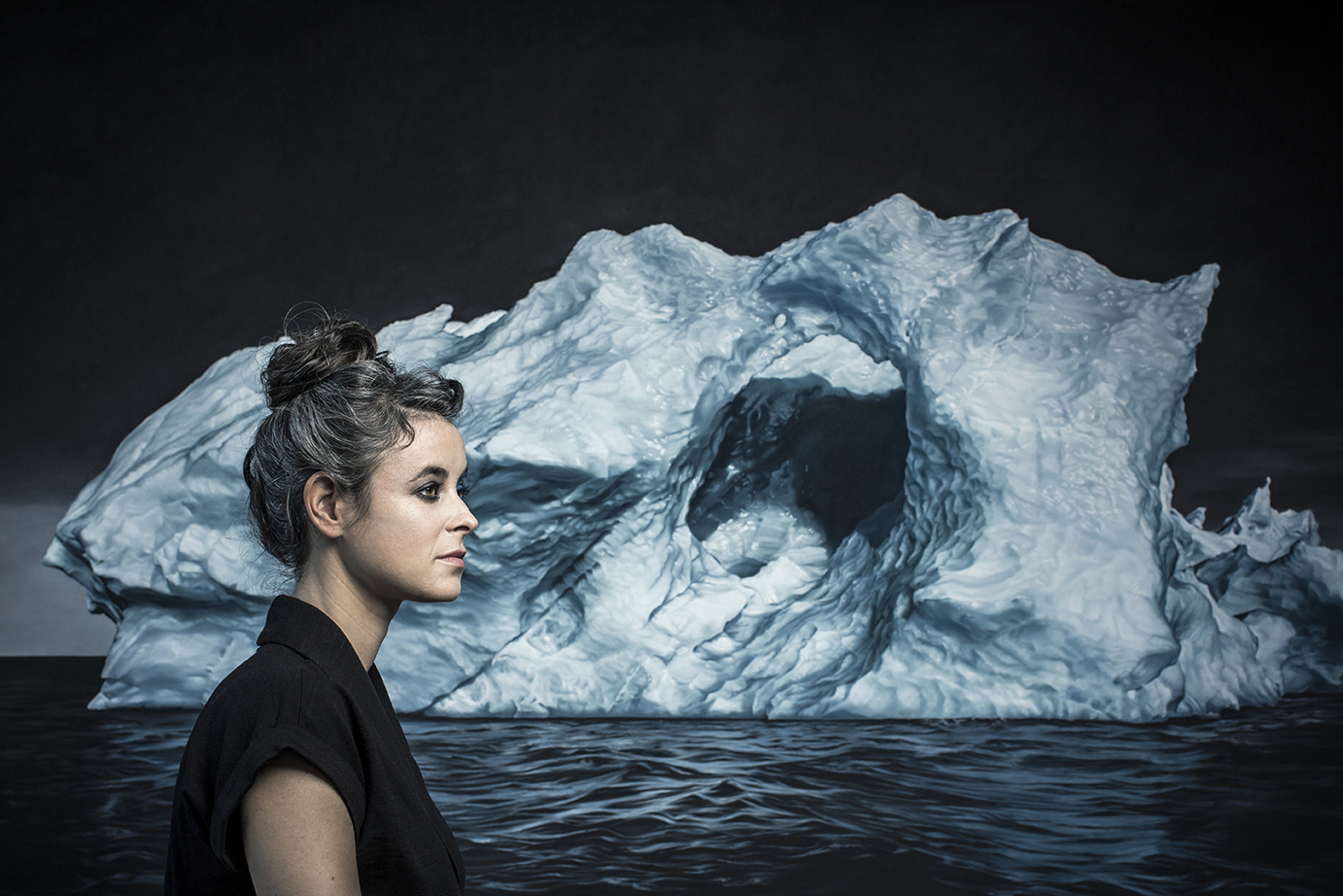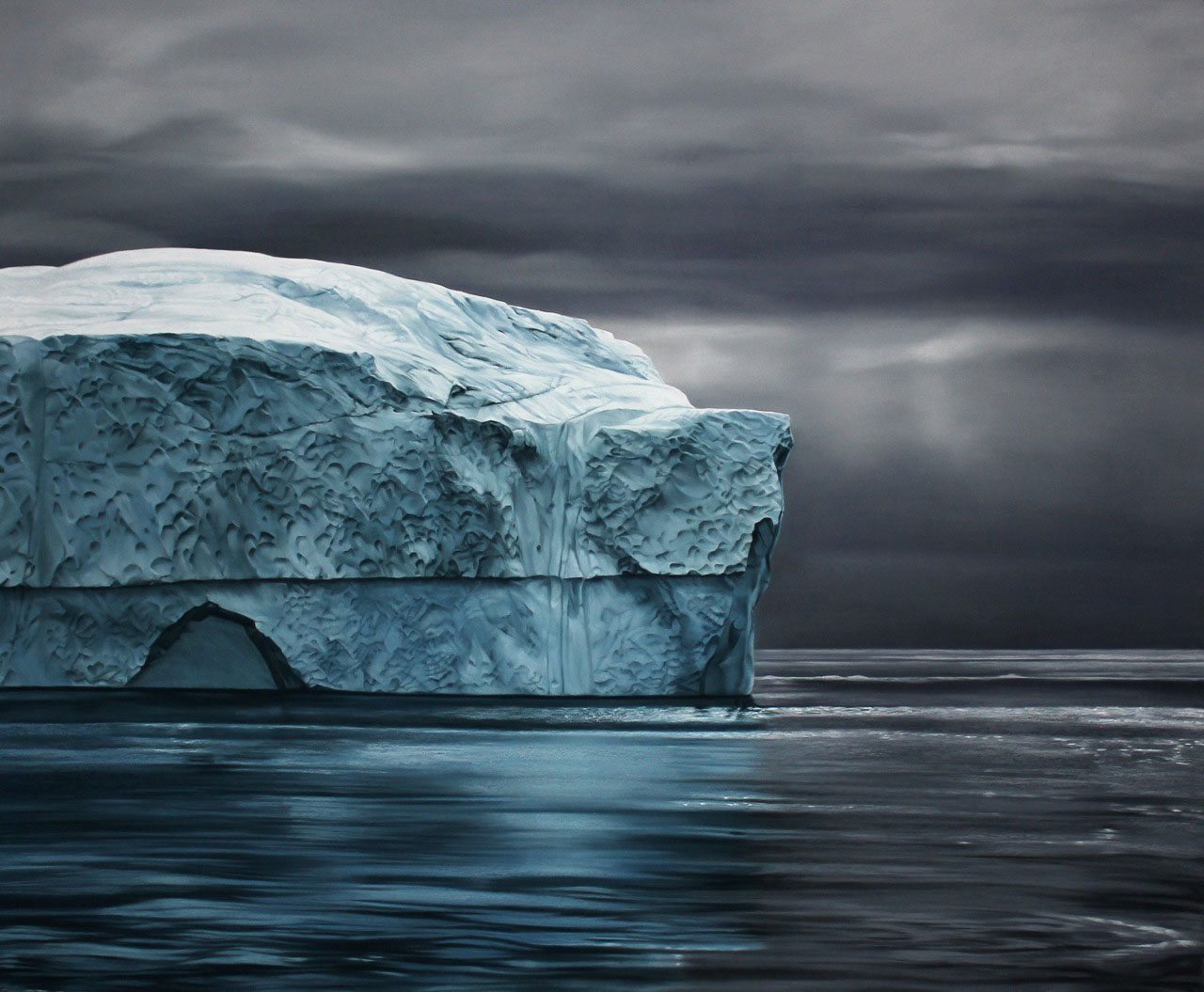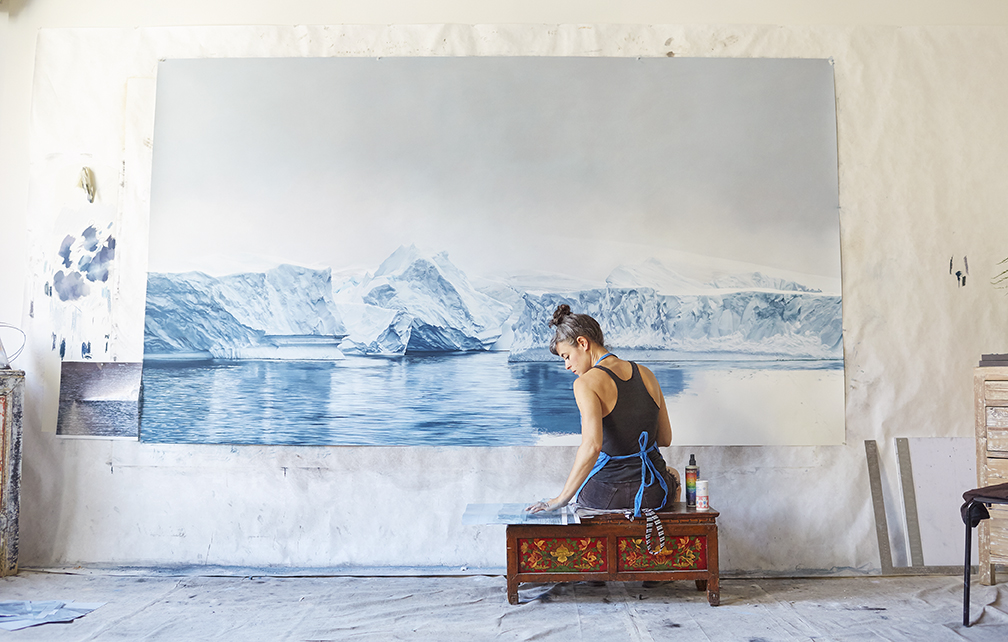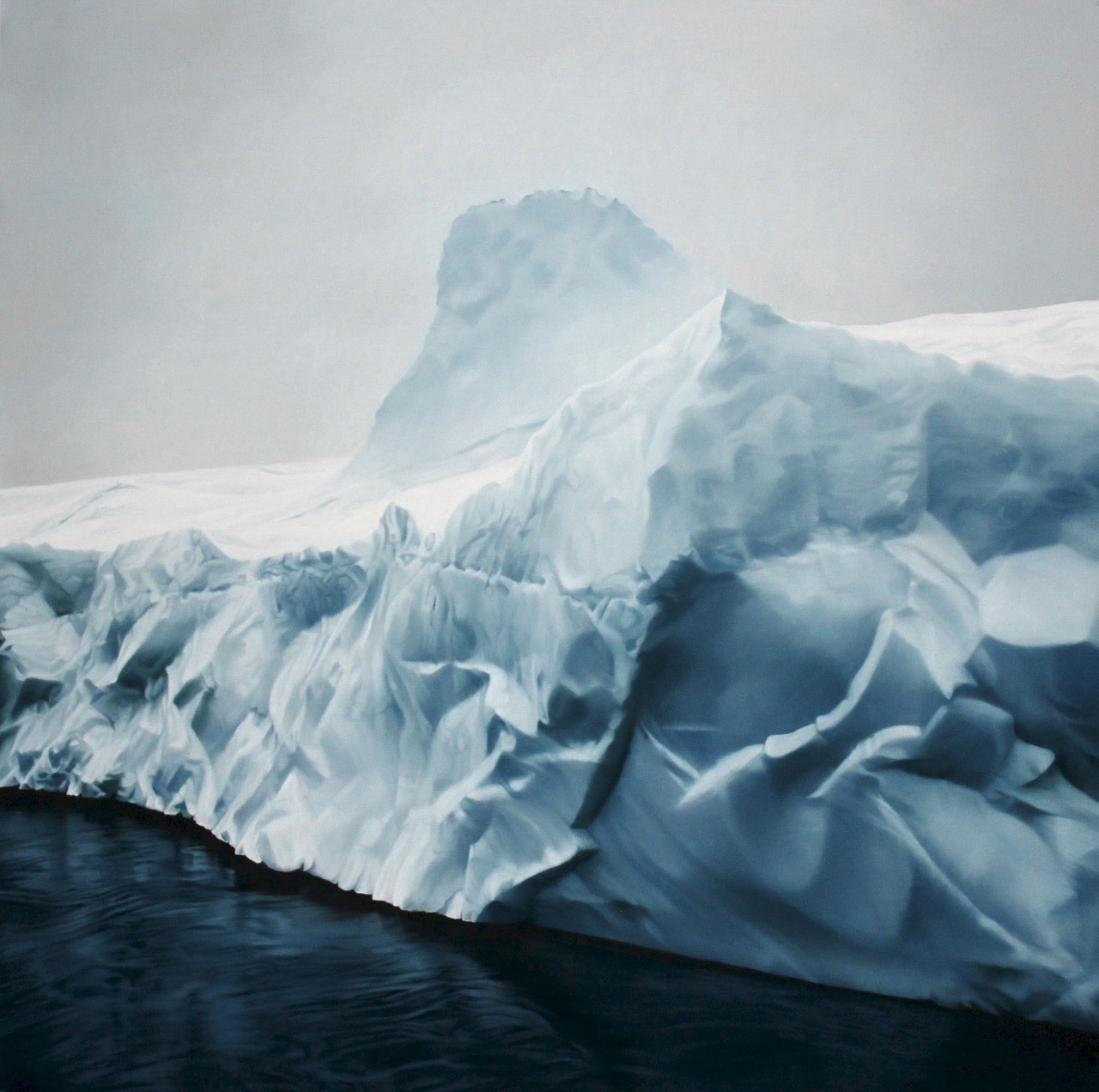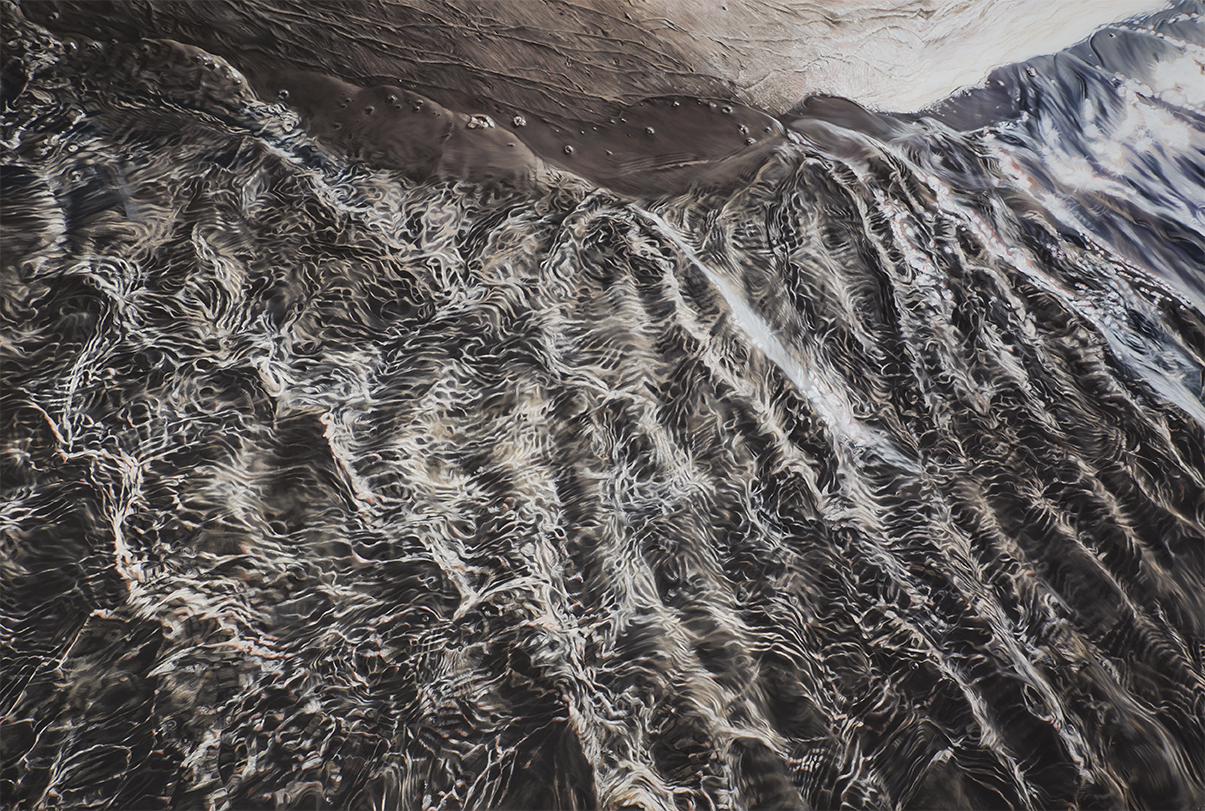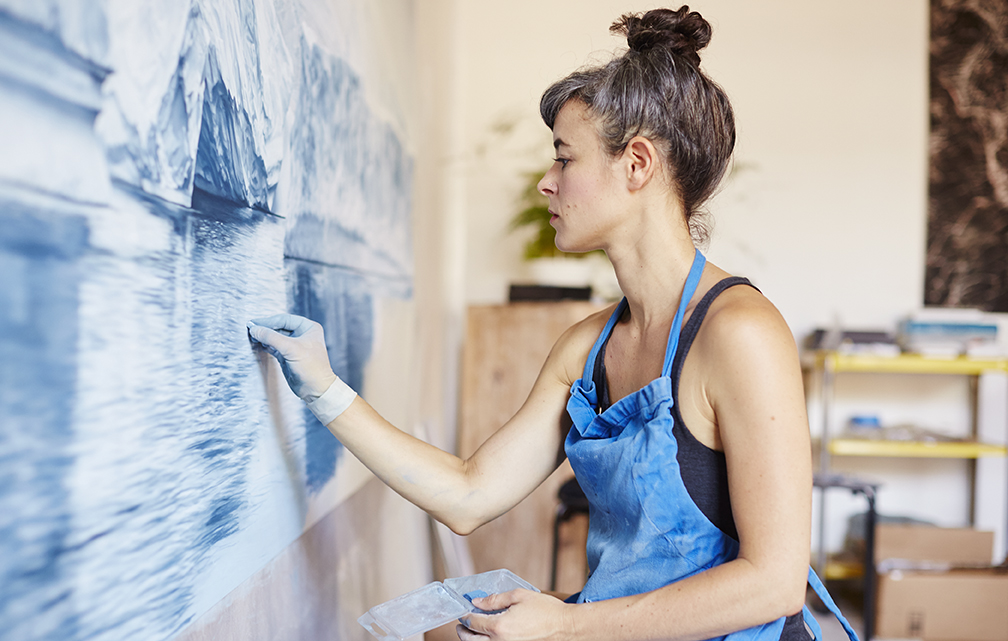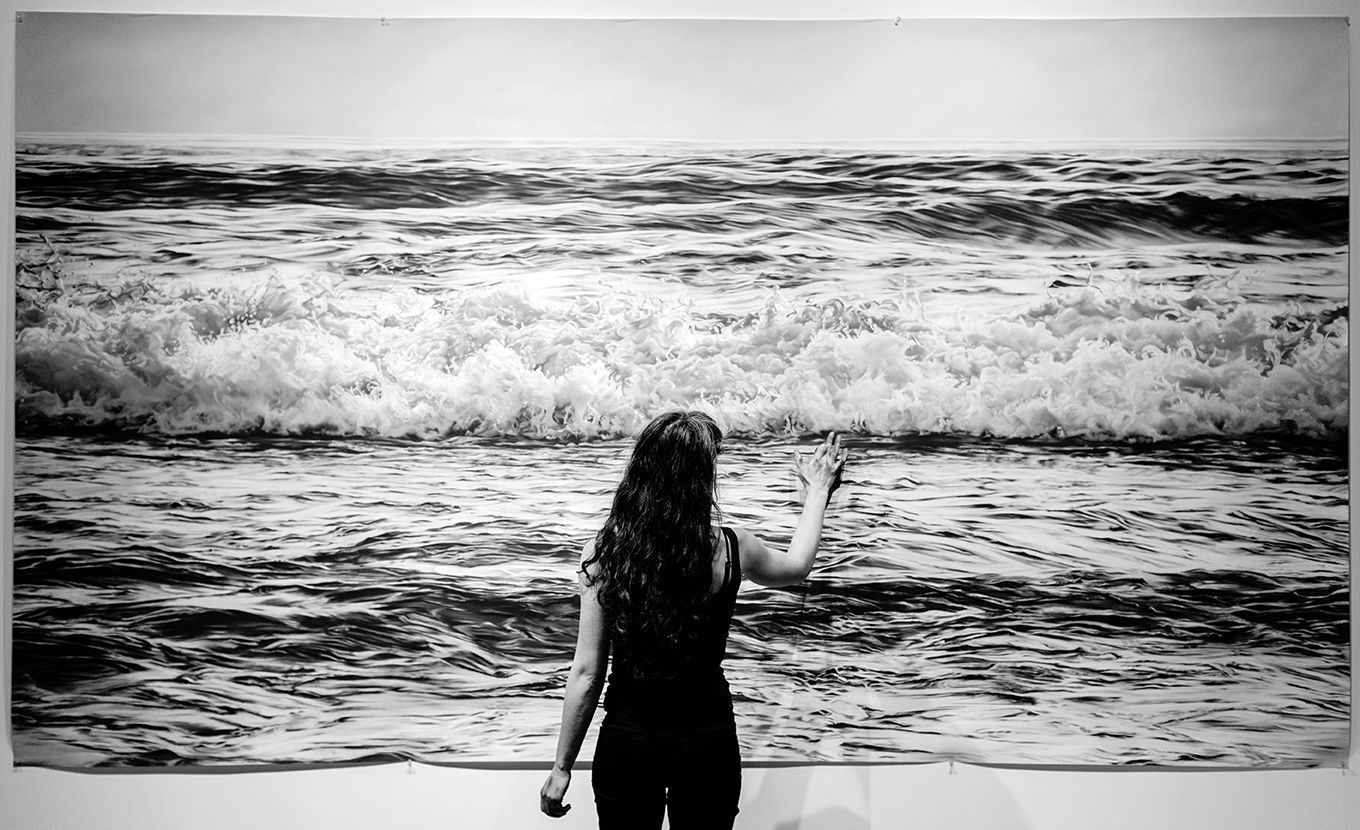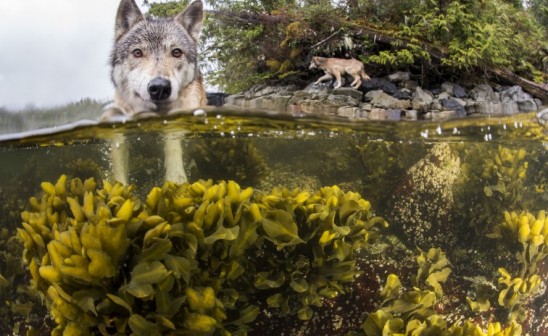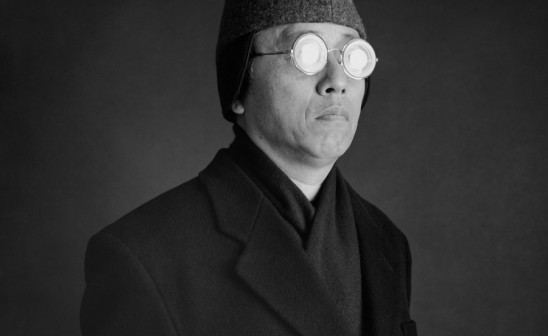I consider my life's mission is to convey the urgency of climate change through art
Greenland #71, 50” x 60”, Soft Pastel on Paper, 2014
Courtesy of the artist Zaria Forman / ©Dustin Cohen
On the occasion of the 21st United Nations Climate Change Conference (COP21), we are launching the "Artists United for the Ocean" initiative. We couldn't think of a better way of starting our campaign, than showing the work from one of the most inspiring artists we've had the opportunity to interview. American artist Zaria Forman has been choosing to convey the beauty in nature, as opposed to the devastation. Traveling to remote places like Antarctica, Greenland, Maldives, Hawaii or Israel, she has brought awareness to polar ice melt, rising sea levels and the cultural and socio-political implications of these phenomena through art and creativity.
Lemarie Channel, Antarctica, 44” x 60”, Soft Pastel on Paper, 2015
Courtesy of the artist Zaria Forman
Zaria grew up in Piermont, NY, about 30 minutes north of NYC. She went to Green Meadow Waldorf School, a small school with an alternative approach to education in which art is greatly infused. "I've been drawing ever since I could hold a crayon. But there was actually never a moment when I decided to make art a career." However, Zaria became an exceptional artist creating breathtaking soft pastel finger paintings. Thanks to a very meticulous process, Zaria produces large pieces of art with mainly blue and white soft pastels. Inspired by the immenseness of the sky and sea, her work highlights the dichotomy between the beauty of natural elements and the effects of climate change on Earth. As a tribute to her mother, the american artist recreates frozen landscapes often more authentic than the original. She dedicated her career and artistic approach to the protection of the environment and plays a part in saving our planet. "I hope my drawings can serve as records of landscapes in flux, honoring the transition, and inspiring our global community to take action for the future." During the time of an interview, Zaria brings us to the Arctic, Greenland, the Maldives and around the Globe wherever there is water. She explains: "I consider my life's mission is to to convey the urgency of climate change through art".
Svalbard #33, 60” x 90”, Soft Pastel on Paper, 2014
Courtesy of the artist Zaria Forman
What are your main inspirations as an artist today?
The inspiration for my drawings began in my early childhood when I traveled with my family throughout several of the world’s most remote landscapes, which became the subject of my mother's fine art photography. I developed an appreciation for the beauty and vastness of the ever-changing sky and sea. I loved watching a far-off storm on the western desert plains; the monsoon rains of southern India; and the cold arctic light illuminating Greenland's waters.
Could you tell us more about the meticulous process of creation?
When I travel, I take thousands of photographs. I often make a few small sketches on-site to get a feel for the landscape. Once I return to the studio, I draw from my memory of the experience, as well as my photographs, to create large-scale compositions. Occasionally I will re-invent the water or sky, alter the shape of the ice, or mix and match a few different images to create the composition I envision. I begin with a very simple pencil sketch so I have a few major lines to follow, and then I add layers of pigment onto the paper, smudging everything with my palms and fingers and breaking the pastel into sharp shards to render finer details. I spray a light, non-toxic fixative between layers, to help fix the pigment onto the paper, it only takes a moment to dry and I usually work on another area while I wait, or spray just before I take a break. That being said, the drawings do take several hundred hours to create, simply because they are very detailed and very large. The process of drawing with pastels is simple and straightforward: cut the paper, make the marks. The material demands a minimalistic approach, as there isn't much room for error or re-working since the paper’s tooth can hold only a few thin layers of pigment. I rarely use an eraser. I prefer to work with my “mistakes,” enjoying the challenge of resolving them with limited marks. I love the simplicity of the process, and it has taught me a great deal about letting go. Drawing is a kind of meditation for me. It’s as if nothing else in the world exists when I am close up and intensely focused. I don’t see what I am drawing as water, or ice, rather the elements are stripped down to their most basic form of color and shape.
Courtesy of the artist Zaria Forman / ©Brian Maranan Pineda
What message do you want to send to the viewer?
Artists play a critical role in communicating climate change, which is arguably the most important challenge we face as a global community. Studies have shown that art can impact viewers’ emotions more effectively than an essay or a doom and gloom newspaper article. Neuroscience tells us that humans take action and make decisions based on emotion above all else. My career is dedicated to translating and illuminating scientists’ warnings and statistics into an accessible medium that people can connect with, on a level that might be deeper than scientific facts can penetrate. My drawings explore moments of transition, turbulence, and tranquility in the landscape, allowing viewers to emotionally connect with a place they may never have the chance to visit. I choose to convey the beauty, as opposed to the devastation. If people can experience the sublimity of these landscapes, perhaps they will be inspired to protect and preserve them.
In 2012, you undertook an unique journey up the North Coast of Greenland. Can you tell us more about this Arctic expedition?
In August 2012, I led an Arctic expedition up the North West coast of Greenland. Called "Chasing the Light", it was the second expedition the mission of which was to create art inspired by this dramatic geography. The first, in 1869, was led by the American painter William Bradford. My mother, Rena Bass Forman, had conceived the idea for the voyage, but did not live to see it through. During the months of her illness, her dedication to the expedition never wavered and I promised to carry out her final journey.
Greenland #72, 60” x 60”, Soft Pastel on Paper, 2014
Courtesy of the artist Zaria Forman
In September 2013, you left to the Maldives, the lowest-lying country in the world slowly being swallowed by the sea. It must have been a very powerful experience.
Exploring the flat islands of the Maldives, I felt a dueling sense of power and fragility. The looming, vast ocean demanded my attention, as it closed in on each tiny island. The color, clarity, and warmth of the water invited me while ominous waves crashed along the encroaching coastline. Traveling with me on these adventures were two artists, painter Lisa Lebofsky and filmmaker Drew Denny. From our shared experiences together, the three of us developed Ice to Islands, a project documenting disappearing landscapes and sharing the stories of people most affected by climate change. Ice to Islands invites viewers to share the urgency of the Greenlandic and Maldivian predicaments in a productive and hopeful way. Our goal is to facilitate a deeper understanding of these crises, helping to find meaning and optimism amidst the chaos of melting, sinking ground. The project continues to evolve and take shape through drawings, paintings, film, exhibitions, performance, and education.
During our month in the Maldives, the changes due to rising seas were evident. We visited the Maldivian Department of Meteorology to discuss this with meteorologists and climatologists. The head of the department explained, chillingly, that if sea levels rise 88 centimeters, 80 percent of the Maldives will be gone. According to current scientific predictions, this could happen by the year 2100.
Maldives #14, 60” x 90”, Soft Pastel on Paper, 2015
Courtesy of the artist Zaria Forman
We encountered a range of responses to climate change among the people we met on the islands. Almost everyone is well aware of the situation, yet they seem unconcerned about the future of their homes. I wonder now if they are in denial. Acknowledging the imminent disappearance of one’s entire homeland must be devastating. The Maldives are situated atop a submarine ridge of natural coral, which many locals believe will grow faster than the seas can rise, lifting their islands to safety. But this is not possible: ocean warming and acidification are destroying the delicate coral ecosystems. Others are well aware of the current scientific predictions and are purchasing land in Sri Lanka and other locations for their families, when the time comes to relocate.
In collaboration with an environmental organization in the Maldives called Ecocare, Drew, Lisa and I offered a workshop and presentation at the Iskandar School in Male, the nation’s capitol. We met with middle-school students to share the concept of our project and what we had learned from speaking with scientists. Providing art materials, we invited them to document their homeland as it transforms throughout their lives. Our hope is that the children, through their creativity, can both spread awareness of the urgency of climate change and inwardly process the ecological transformations surrounding them.
Courtesy of the artist Zaria Forman / ©Brian Maranan Pineda
With 70 exhibitions under your belt, you seem to be a very busy artist. Looking to the future, what can we look forward to coming up with you?
I have been very busy indeed! Just to name a few things: Banksy contacted me a couple months ago to invite me to participate in his exhibit Dismaland, which just ran for 5 weeks in the UK and came down on Sunday. The show has been written up world wide and I was quoted in the NYTimes' article. I also had a solo show at Winston Wächter Fine Art in New York until Oct 17th, 2015. All the work in the show sold out a couple weeks before it even opened- a very rare occurrence in the art world these days! My drawing is on the cover of the current issue of American Art Collector Magazine, and my current exhibit is featured inside. On November 5th and 6th I'll be speaking at a live TED event in NYC. November 7th I leave for a 5 week art residency in Antarctica, aboard the National Geographic Explorer with Lindblad Expeditions.
Courtesy of the artist Zaria Forman / ©Trevor Traynor
More of Zaria Forman's work on her website


